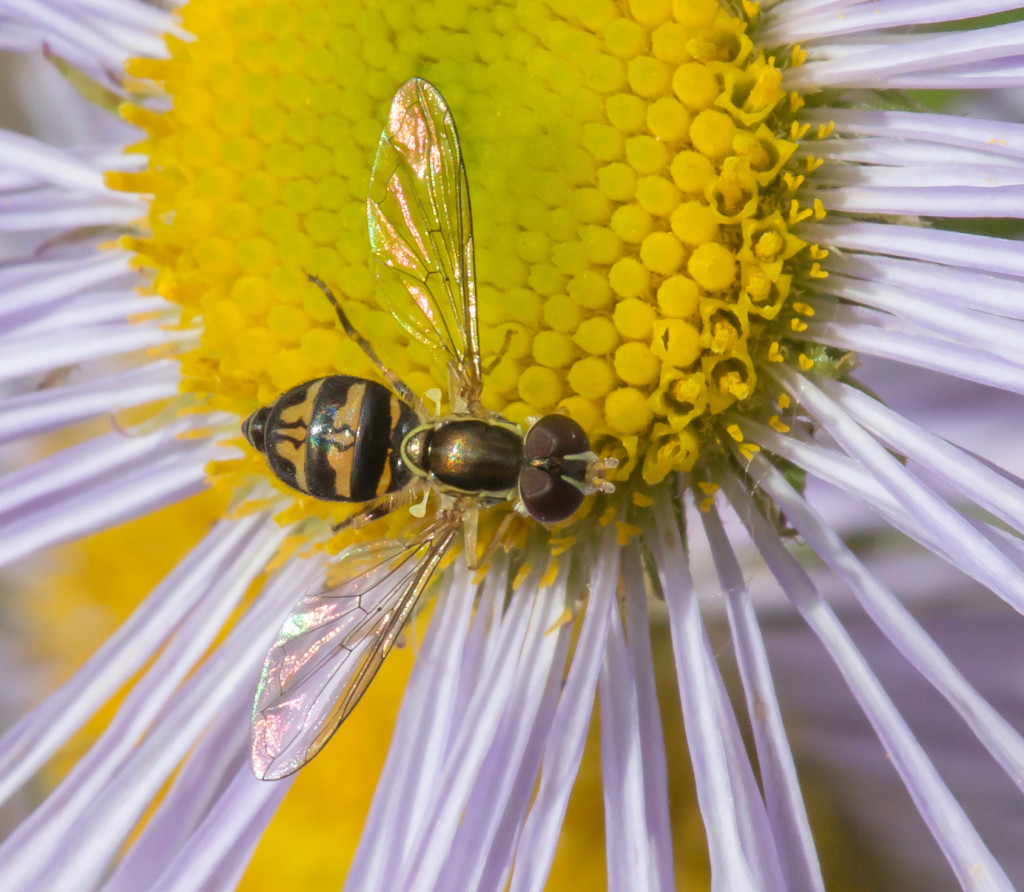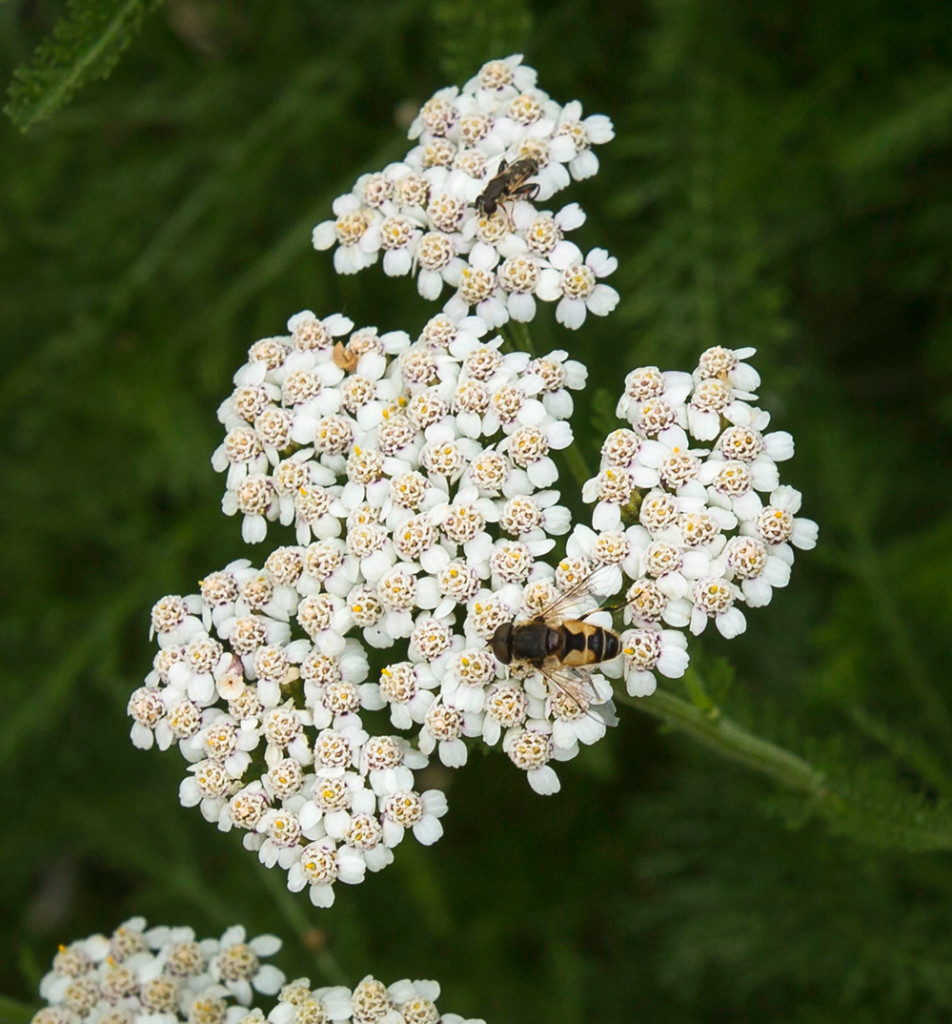
Toxomerus occidentals (female), soaking up nectar on showy fleabane (Erigeron specious)
Beneficial in many ways, syrphid flies — also called flower flies — are true flies in the order Diptera, family Syrphidae. Some can be recognized by their ability to dart around as well as hover in the air in one place, wings nearly invisible, as they search for flowers on which to feed—somewhat like a tiny helicopter, but with much more grace (this flair led to their other common name, hover fly). They come in various shapes and sizes (typically 1/4 to 3/4 inch in length); the tiny ones require a hand lens or macro lens to get a good look. And when you do, you’ll be amazed at the beautiful patterns and bright colors that often serve to mimic dangerous looking bees or wasps and fool predators like birds into leaving them alone (but don’t worry, they couldn’t sting you if they wanted to!).

Syrphids in the genus Spilomyia often mimic wasps, with vivid yellow and black patterns and modified antennae.
Multi-functional
Not needing to carry and store pollen for their young (like most bees do) doesn’t prevent them from being extremely important pollinators. Researchers have found that although syrphid flies pollinate less effectively per flower visit, they visit flowers more often, resulting in essentially the same pollination services as bees. And, it’s thought that they may be more tolerant of the landscape changes that we humans insist on, than bees are.
But syrphid flies are not only important as pollinators in gardens, organic farms, and wild areas. During their immature stage, most species that are found in gardens and nearly half of the 6,000 syrphid fly species worldwide are voracious consumers of aphids, scale insects, and other soft-bodied pests. In coastal Central California, researchers compared romaine lettuce sprayed with an insecticide and lettuce without insecticide. They found that syrphid larvae were primarily responsible for suppressing aphids in organic romaine lettuce, and called the sprayed lettuce “unmarketable.” Other types of syrphid fly larvae are either (1) scavengers that tidy up ant, bee, and wasp nests, (2) feeders of plant material, tree sap, and fungi, or (3) decomposers that feed on decaying organic matter. To add to their achievements, larvae are reportedly more effective in cool weather (as in early spring) than most other such predators.

Myathropa florea, male. Larvae of this species feed on bacteria at the base of trees or in decaying leaves.
Life Cycle
Females lay their tiny, elongated eggs singly on leaves—typically near aphid colonies, so food is within reach—and they hatch in a few days. The tapered, grub-like larvae are blind and legless, but the mouths of these aphid-eaters are equipped with triple-pointed darts that enable them to pierce and suck their prey dry. At maturation, the larvae are promoted to the soil to become pupa and, eventually, adult flies. Their life cycle takes several weeks; reportedly three generations per year are typical in the Northwest. Most syrphid flies overwinter as larvae in leaf litter—yet another reason to not remove fallen leaves from soil!
Close encounters
The best way to spot these helpful, colorful little insects in your garden is to move slowly and quietly, and observe carefully. Sometimes all I have to do is pause next to a group of flat-topped flowers (white or yellow ones seem to be their favorites), and within a few minutes one or two will show up to eat (and to dazzle me—in morning sunlight these exceptional little pollinators shimmer!). I’ve photographed nine different species in my small yard, and I’ve just started. Hopefully I’ll encounter many more of these fascinating little flyers in the years to come.
To avoid confusion with bees and wasps, just remember that syrphid flies have huge compound eyes (which help to determine their gender—female eyes are spaced slightly apart while males’ come together at the top of their head); their bodies are sometimes flatter than bees and wasps; their antennae are usually very short; they don’t carry pollen around like most bees do; they have one pair of wings (unlike bees and wasps that have two pairs). The second pair of wings of flies has been reduced to two little knobs called halteres, which can be seen in the photo below. Halteres function like tiny gyroscopes that allow them to stay balanced by detecting and correcting changes in rotation while flying, and enable their zippy acrobatic flights.
Although the mouth parts of syrphids vary between species, allowing different species to access nectar in differently shaped flowers, their typical mouth is basically a retractable extension with a spongelike tip that can soak up either nectar or pollen. The species that have this can only feed on open flowers that have easily accessible nectar. Some species have a modified mouth that allows them to feed at elongated, tubular flowers.

The halteres can be seen at the base of the wings.
Conservation
Syrphid flies have been studied very little in the U.S., but European research has shown that species diversity has fallen in areas of intensive human activity. According to the Xerces Society, in Britain, seven of the 22 flies for which Biodiversity Action Plans have been prepared are syrphid flies. Given the substantial loss of pollinators induced by habitat loss, pesticides, nonnative species and climate chaos, and the profusion of others in danger of extinction, there is a definite need to conserve all types of wild pollinator communities.
Providing for these flies is similar to most other pollinators: A variety of flowers from spring till fall for adults, and appropriate habitat for egg laying, larval development, and overwintering. Attract and nurture syrphid flies with a diversity of native plants that provide a lot of nectar and pollen (females need pollen to produce eggs). In the Pacific Northwest, try yarrow (Achillea millefolium var. occidentalis), stonecrop (Sedum spp.), goldenrod (Solidago canadensis), blue-eyed grass (Sisyrinchium spp.), fleabane (Erigeron spp.), white spiraea (Spiraea betulifolia var. lucida), mock orange (Philadelphus lewisii), and aster (Symphiotrichum spp.). The flowers of chamomile, dill, parsley, and other garden herbs with flat-topped flowers are also very attractive to them, as is the pollen of grasses and sedges that’s often available early in the season. Be sure to allow leaf litter and downed wood to remain on soil to help them get through the winter and to provide food for the decomposer types.
Aphid remedy
If you have an aphid problem on some plants, remember that predatory insects that keep pests at acceptable levels need prey like aphids. Always inspect aphid colonies for syrphid fly larvae before even thinking about control, even “organic” remedies. Use only plain water to spray off aphids (that can’t climb back on), but only if necessary. Never, ever use insecticides, to which syrphid flies and other creatures are very sensitive. Usually, just turning your back is the best thing: One summer a large patch of native bleeding heart (Dicentra formosa) in my backyard was absolutely infested with aphids. I decided to let nature take her course—cheering on the ladybird beetles and birds who flourished with the situation. As the leaves died back (as they do naturally when the heat of summer arrives) I forgot about the aphids. The following year there were scarcely any on the bleeding heart, but I found another species of aphid on nodding onion (Allium cernuum); again I did nothing and nature took care of it. The following year the wild onion and bleeding heart were fine, but the aspen trees were stricken. Yet again, ladybugs, lacewings, and several species of songbirds took advantage of the generous buffet. The following year there were no outbreaks in my yard, at least none that I noticed.

Syrphus opinator (female) on white spiraea (Spiraea betulifolia var. lucida)

Eristalis sp. on yarrow (Achillea millefolium var. occidentalis)
To leave a comment, click on post’s title